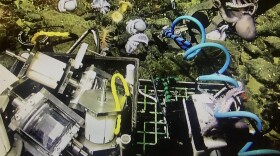During a recent expedition to study the largest octopus garden ever discovered, scientists stumbled across a second garden about 5 miles away. Located off the coast of Central California, these gardens are home to thousands of octo-moms who have come to take care of their eggs. KAZU News caught up with the scientists to learn more about what will come of their expedition.
The octopus gardens are located two miles below the ocean’s surface near an extinct underwater volcano called the Davidson Seamount. The seamount is part of the Monterey Bay National Marine Sanctuary, which stretches along the Central Coast from the Golden Gate Bridge in San Francisco to Hearst Castle near San Simeon. This sanctuary is teeming with life, from sea otters and sponges the size of sofas to new discoveries like the octopus gardens.
“I think a lot of people think you need to go up into outer space to discover something new. But really you just have to dive below the surface and to start looking around,” said Ecosystem Scientist Jennifer Brown.
In this case, diving with underwater robots, deep down into a dark and freezing world pulsing with octopus.
Just a few weeks ago, Brown, a contractor for the Marine Sanctuary, was out at sea with dozens of other scientists exploring the octopus gardens. The team worked from a boat called the E/V Nautilus, which is owned and operated by Ocean Exploration Trust. It’s equipped with two ROVs, or remotely-operated vehicles.
The ROVs collected water samples, temperature and dissolved oxygen readings. They also captured video that was live streamed to the public.

Now back from the expedition, Brown and other scientists are reviewing the 65 plus hours of footage showing hundreds of octopus nestled into the rocks.
“These octopus moms are, they're really beautiful. They're kind of a lavender on the top portion of their body. And underneath, they're bright white,” Brown said.
Scientists first discovered the octopus garden a year ago. The name “octopus garden” stuck in part because of the Beatles song, but also because of the way the creatures line up in rows, like crops in a field.

“We know there’s well over a thousand there,” said Chad King in his office at the Monterey Bay National Marine Sanctuary in Monterey.
King is a research specialist with the Marine Sanctuary and was also lead scientist on the expedition.
“We hadn’t surveyed this entire little bump on the seafloor, which is about a kilometer by 600 meters, so we covered it fairly well and we have the video. So now, we can go back and actually count the individual octopus,” said King.
Scientists do know what the octo-moms are doing here. They’re brooding, or taking care of their eggs.
The only other cluster of brooding octopus is located off Costa Rica. It’s smaller and so far, reproduction hasn’t been successful there. Since the discovery of the cluster in 2013, King says there haven’t been any hatchlings or any development in the eggs.
Off California, scientists have witnessed over a dozen octopus babies hatch into the environment. They can also see their eye spots and little octopus arms through the egg capsules. The brooding octopus moms turn upside down to take care of their eggs, pumping their siphons to deliver oxygen and twirling their arms to keep them clean.

“But the most important thing about brooding is not just taking care of them in that way… but also protecting them from predators,” King said.
Scientists aren’t sure why the moms have chosen this spot off California. It could be the relatively warmer water that’s seeping out of the seafloor, creating a shimmering effect. King says this may speed up the development of the octopus babies. Deep sea octopus are known to take a long time to brood.
“We do think it's something about the water itself, the chemistry, the temperature or something else, but we're just not sure. And that's what we're going to try and answer in the years to come,” King said.
Samples collected from the octopus gardens off California are being sent to experts around the world, in Italy, Chicago, Texas, Alaska, Los Angeles and more.
Amanda Kahn says it takes a team to study new discoveries like this.
“Part of the fun of being out studying the deep sea is how much is not known” she said.
Kahn was also onboard the expedition. She’s an invertebrate ecologist and an assistant professor at Moss Landing Marine Labs. She also collaborates with the Monterey Bay Aquarium Research Institute.
In a lab at the Research Institute, she unscrews a jar containing a female octopus. Scientists collected a juvenile, male and female octopus to preserve in ethanol for further research.

Kahn says they can learn a lot from these three octopus. First, it helped confirm the species: Muusoctopus robustus. They will also be able to do a DNA analysis and study the chemical composition of the tissues to help determine what these octopus ate before they laid their eggs. In general, octo-moms don’t typically feed after they lay their eggs. So the moms will waste away and die after they brood.
The more these scientists learn about the octopus gardens, the more questions they seem to have. And that’s not overwhelming to Kahn, it’s just plain exciting.

“We've only just found it. And to think that we can still discover things like the way that the old time naturalists would go to a new place like Charles Darwin would go and just catalog what he saw... I mean, that's amazing that we're still discovering things at that scale,” Kahn said.
The scientists left instruments down in the octopus gardens that will continue to measure temperature and dissolved oxygen over the course of the year. They hope to collect those instruments in 2020.



